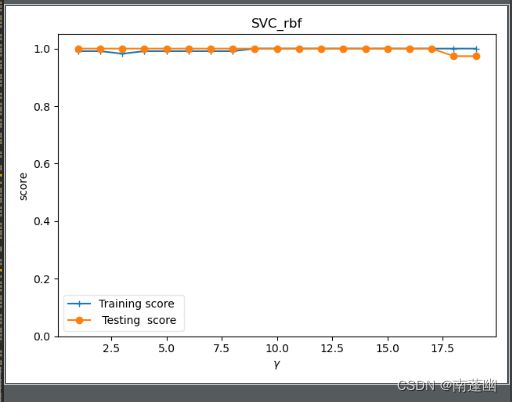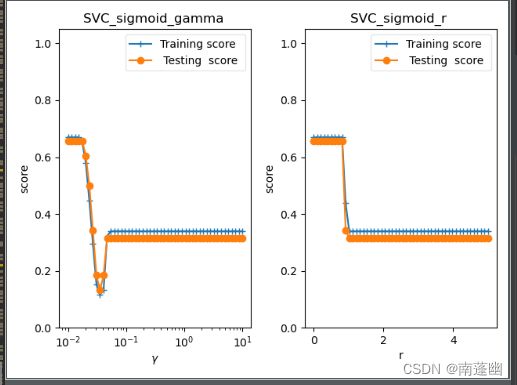文章目录
- 支持向量机实例
-
- 1.线性核函数
- 2.多项式核函数
- 3.RBF高斯核函数
- 4.sigmoid核函数
- 代码:
- 结果:
支持向量机实例
1.线性核函数
def test_SVC_linear():
'''
测试 SVC 的用法。这里使用的是最简单的线性核
:param data: 可变参数。它是一个元组,这里要求其元素依次为训练样本集、测试样本集、训练样本的标记、测试样本的标记
:return: None
'''
iris = datasets.load_iris()
X_train, X_test, y_train, y_test=train_test_split(iris.data, iris.target, test_size=0.25,
random_state=0,stratify=iris.target)
cls=SVC(kernel='linear')
cls.fit(X_train,y_train)
print('Coefficients:%s, intercept %s'%(cls.coef_,cls.intercept_))
print('Score: %.2f' % cls.score(X_test, y_test))
2.多项式核函数
def test_SVC_poly():
'''
测试多项式核的 SVC 的预测性能随 degree、gamma、coef0 的影响.
:param data: 可变参数。它是一个元组,这里要求其元素依次为训练样本集、测试样本集、训练样本的标记、测试样本的标记
:return: None
'''
iris = datasets.load_iris()
X_train, X_test, y_train, y_test = train_test_split(iris.data, iris.target, test_size=0.25,
random_state=0, stratify=iris.target)
fig=plt.figure()
degrees=range(1,20)
train_scores=[]
test_scores=[]
for degree in degrees:
cls=SVC(kernel='poly',degree=degree,gamma='auto')
cls.fit(X_train,y_train)
train_scores.append(cls.score(X_train,y_train))
test_scores.append(cls.score(X_test, y_test))
ax=fig.add_subplot(1,3,1)
ax.plot(degrees,train_scores,label="Training score ",marker='+' )
ax.plot(degrees,test_scores,label= " Testing score ",marker='o' )
ax.set_title( "SVC_poly_degree ")
ax.set_xlabel("p")
ax.set_ylabel("score")
ax.set_ylim(0,1.05)
ax.legend(loc="best",framealpha=0.5)
gammas=range(1,20)
train_scores=[]
test_scores=[]
for gamma in gammas:
cls=SVC(kernel='poly',gamma=gamma,degree=3)
cls.fit(X_train,y_train)
train_scores.append(cls.score(X_train,y_train))
test_scores.append(cls.score(X_test, y_test))
ax=fig.add_subplot(1,3,2)
ax.plot(gammas,train_scores,label="Training score ",marker='+' )
ax.plot(gammas,test_scores,label= " Testing score ",marker='o' )
ax.set_title( "SVC_poly_gamma ")
ax.set_xlabel(r"$\gamma$")
ax.set_ylabel("score")
ax.set_ylim(0,1.05)
ax.legend(loc="best",framealpha=0.5)
rs=range(0,20)
train_scores=[]
test_scores=[]
for r in rs:
cls=SVC(kernel='poly',gamma=10,degree=3,coef0=r)
cls.fit(X_train,y_train)
train_scores.append(cls.score(X_train,y_train))
test_scores.append(cls.score(X_test, y_test))
ax=fig.add_subplot(1,3,3)
ax.plot(rs,train_scores,label="Training score ",marker='+' )
ax.plot(rs,test_scores,label= " Testing score ",marker='o' )
ax.set_title( "SVC_poly_r ")
ax.set_xlabel(r"r")
ax.set_ylabel("score")
ax.set_ylim(0,1.05)
ax.legend(loc="best",framealpha=0.5)
plt.show()
3.RBF高斯核函数
ef test_SVC_rbf():
'''
测试 高斯核的 SVC 的预测性能随 gamma 参数的影响
:param data: 可变参数。它是一个元组,这里要求其元素依次为训练样本集、测试样本集、训练样本的标记、测试样本的标记
:return: None
'''
iris = datasets.load_iris()
X_train, X_test, y_train, y_test=train_test_split(iris.data, iris.target, test_size=0.25,
random_state=0,stratify=iris.target)
gammas=range(1,20)
train_scores=[]
test_scores=[]
for gamma in gammas:
cls=SVC(kernel='rbf',gamma=gamma)
cls.fit(X_train,y_train)
train_scores.append(cls.score(X_train,y_train))
test_scores.append(cls.score(X_test, y_test))
fig=plt.figure()
ax=fig.add_subplot(1,1,1)
ax.plot(gammas,train_scores,label="Training score ",marker='+' )
ax.plot(gammas,test_scores,label= " Testing score ",marker='o' )
ax.set_title( "SVC_rbf")
ax.set_xlabel(r"$\gamma$")
ax.set_ylabel("score")
ax.set_ylim(0,1.05)
ax.legend(loc="best",framealpha=0.5)
plt.show()
4.sigmoid核函数
def test_SVC_sigmoid():
'''
测试 sigmoid 核的 SVC 的预测性能随 gamma、coef0 的影响.
:param data: 可变参数。它是一个元组,这里要求其元素依次为训练样本集、测试样本集、训练样本的标记、测试样本的标记
:return: None
'''
iris = datasets.load_iris()
X_train, X_test, y_train, y_test=train_test_split(iris.data, iris.target, test_size=0.25,
random_state=0,stratify=iris.target)
fig=plt.figure()
gammas=np.logspace(-2,1)
train_scores=[]
test_scores=[]
for gamma in gammas:
cls=SVC(kernel='sigmoid',gamma=gamma,coef0=0)
cls.fit(X_train,y_train)
train_scores.append(cls.score(X_train,y_train))
test_scores.append(cls.score(X_test, y_test))
ax=fig.add_subplot(1,2,1)
ax.plot(gammas,train_scores,label="Training score ",marker='+' )
ax.plot(gammas,test_scores,label= " Testing score ",marker='o' )
ax.set_title( "SVC_sigmoid_gamma ")
ax.set_xscale("log")
ax.set_xlabel(r"$\gamma$")
ax.set_ylabel("score")
ax.set_ylim(0,1.05)
ax.legend(loc="best",framealpha=0.5)
rs=np.linspace(0,5)
train_scores=[]
test_scores=[]
for r in rs:
cls=SVC(kernel='sigmoid',coef0=r,gamma=0.01)
cls.fit(X_train,y_train)
train_scores.append(cls.score(X_train,y_train))
test_scores.append(cls.score(X_test, y_test))
ax=fig.add_subplot(1,2,2)
ax.plot(rs,train_scores,label="Training score ",marker='+' )
ax.plot(rs,test_scores,label= " Testing score ",marker='o' )
ax.set_title( "SVC_sigmoid_r ")
ax.set_xlabel(r"r")
ax.set_ylabel("score")
ax.set_ylim(0,1.05)
ax.legend(loc="best",framealpha=0.5)
plt.show()
代码:
import numpy as np
from sklearn import datasets
from sklearn.model_selection import train_test_split
from sklearn.svm import SVC
import matplotlib.pyplot as plt
def test_SVC_linear():
'''
测试 SVC 的用法。这里使用的是最简单的线性核
:param data: 可变参数。它是一个元组,这里要求其元素依次为训练样本集、测试样本集、训练样本的标记、测试样本的标记
:return: None
'''
iris = datasets.load_iris()
X_train, X_test, y_train, y_test=train_test_split(iris.data, iris.target, test_size=0.25,
random_state=0,stratify=iris.target)
cls=SVC(kernel='linear')
cls.fit(X_train,y_train)
print('Coefficients:%s, intercept %s'%(cls.coef_,cls.intercept_))
print('Score: %.2f' % cls.score(X_test, y_test))
def test_SVC_poly():
'''
测试多项式核的 SVC 的预测性能随 degree、gamma、coef0 的影响.
:param data: 可变参数。它是一个元组,这里要求其元素依次为训练样本集、测试样本集、训练样本的标记、测试样本的标记
:return: None
'''
iris = datasets.load_iris()
X_train, X_test, y_train, y_test = train_test_split(iris.data, iris.target, test_size=0.25,
random_state=0, stratify=iris.target)
fig=plt.figure()
degrees=range(1,20)
train_scores=[]
test_scores=[]
for degree in degrees:
cls=SVC(kernel='poly',degree=degree,gamma='auto')
cls.fit(X_train,y_train)
train_scores.append(cls.score(X_train,y_train))
test_scores.append(cls.score(X_test, y_test))
ax=fig.add_subplot(1,3,1)
ax.plot(degrees,train_scores,label="Training score ",marker='+' )
ax.plot(degrees,test_scores,label= " Testing score ",marker='o' )
ax.set_title( "SVC_poly_degree ")
ax.set_xlabel("p")
ax.set_ylabel("score")
ax.set_ylim(0,1.05)
ax.legend(loc="best",framealpha=0.5)
gammas=range(1,20)
train_scores=[]
test_scores=[]
for gamma in gammas:
cls=SVC(kernel='poly',gamma=gamma,degree=3)
cls.fit(X_train,y_train)
train_scores.append(cls.score(X_train,y_train))
test_scores.append(cls.score(X_test, y_test))
ax=fig.add_subplot(1,3,2)
ax.plot(gammas,train_scores,label="Training score ",marker='+' )
ax.plot(gammas,test_scores,label= " Testing score ",marker='o' )
ax.set_title( "SVC_poly_gamma ")
ax.set_xlabel(r"$\gamma$")
ax.set_ylabel("score")
ax.set_ylim(0,1.05)
ax.legend(loc="best",framealpha=0.5)
rs=range(0,20)
train_scores=[]
test_scores=[]
for r in rs:
cls=SVC(kernel='poly',gamma=10,degree=3,coef0=r)
cls.fit(X_train,y_train)
train_scores.append(cls.score(X_train,y_train))
test_scores.append(cls.score(X_test, y_test))
ax=fig.add_subplot(1,3,3)
ax.plot(rs,train_scores,label="Training score ",marker='+' )
ax.plot(rs,test_scores,label= " Testing score ",marker='o' )
ax.set_title( "SVC_poly_r ")
ax.set_xlabel(r"r")
ax.set_ylabel("score")
ax.set_ylim(0,1.05)
ax.legend(loc="best",framealpha=0.5)
plt.show()
def test_SVC_rbf():
'''
测试 高斯核的 SVC 的预测性能随 gamma 参数的影响
:param data: 可变参数。它是一个元组,这里要求其元素依次为训练样本集、测试样本集、训练样本的标记、测试样本的标记
:return: None
'''
iris = datasets.load_iris()
X_train, X_test, y_train, y_test=train_test_split(iris.data, iris.target, test_size=0.25,
random_state=0,stratify=iris.target)
gammas=range(1,20)
train_scores=[]
test_scores=[]
for gamma in gammas:
cls=SVC(kernel='rbf',gamma=gamma)
cls.fit(X_train,y_train)
train_scores.append(cls.score(X_train,y_train))
test_scores.append(cls.score(X_test, y_test))
fig=plt.figure()
ax=fig.add_subplot(1,1,1)
ax.plot(gammas,train_scores,label="Training score ",marker='+' )
ax.plot(gammas,test_scores,label= " Testing score ",marker='o' )
ax.set_title( "SVC_rbf")
ax.set_xlabel(r"$\gamma$")
ax.set_ylabel("score")
ax.set_ylim(0,1.05)
ax.legend(loc="best",framealpha=0.5)
plt.show()
def test_SVC_sigmoid():
'''
测试 sigmoid 核的 SVC 的预测性能随 gamma、coef0 的影响.
:param data: 可变参数。它是一个元组,这里要求其元素依次为训练样本集、测试样本集、训练样本的标记、测试样本的标记
:return: None
'''
iris = datasets.load_iris()
X_train, X_test, y_train, y_test=train_test_split(iris.data, iris.target, test_size=0.25,
random_state=0,stratify=iris.target)
fig=plt.figure()
gammas=np.logspace(-2,1)
train_scores=[]
test_scores=[]
for gamma in gammas:
cls=SVC(kernel='sigmoid',gamma=gamma,coef0=0)
cls.fit(X_train,y_train)
train_scores.append(cls.score(X_train,y_train))
test_scores.append(cls.score(X_test, y_test))
ax=fig.add_subplot(1,2,1)
ax.plot(gammas,train_scores,label="Training score ",marker='+' )
ax.plot(gammas,test_scores,label= " Testing score ",marker='o' )
ax.set_title( "SVC_sigmoid_gamma ")
ax.set_xscale("log")
ax.set_xlabel(r"$\gamma$")
ax.set_ylabel("score")
ax.set_ylim(0,1.05)
ax.legend(loc="best",framealpha=0.5)
rs=np.linspace(0,5)
train_scores=[]
test_scores=[]
for r in rs:
cls=SVC(kernel='sigmoid',coef0=r,gamma=0.01)
cls.fit(X_train,y_train)
train_scores.append(cls.score(X_train,y_train))
test_scores.append(cls.score(X_test, y_test))
ax=fig.add_subplot(1,2,2)
ax.plot(rs,train_scores,label="Training score ",marker='+' )
ax.plot(rs,test_scores,label= " Testing score ",marker='o' )
ax.set_title( "SVC_sigmoid_r ")
ax.set_xlabel(r"r")
ax.set_ylabel("score")
ax.set_ylim(0,1.05)
ax.legend(loc="best",framealpha=0.5)
plt.show()
if __name__=="__main__":
test_SVC_linear()
test_SVC_poly()
test_SVC_rbf()
test_SVC_sigmoid()
结果:
线性核函数

多项式核函数

RBF高斯核函数

sigmoid核函数




